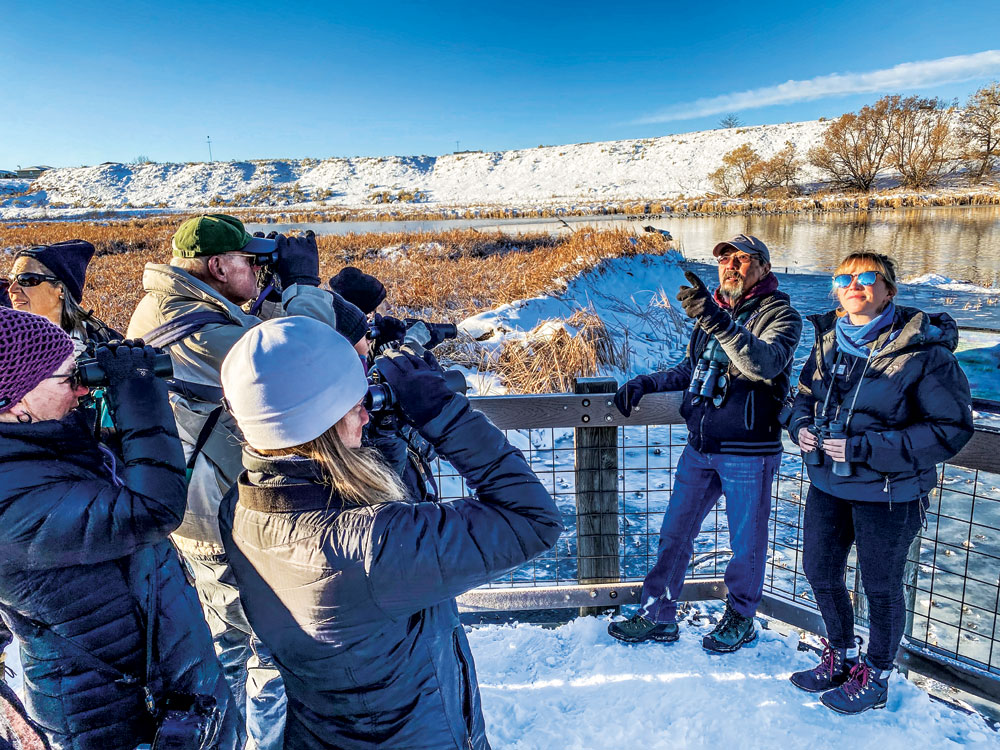
Bluff Lake volunteer George Ho and Executive Director Rachel Crouch lead a group of bird watchers on a monthly walk around Bluff Lake Nature Center. Novice and experienced bird watchers gather the first Saturday of every month at Bluff Lake to observe and record birds. Over the past two decades, more than 193 species of birds have been spotted at Bluff Lake.
On a recent Saturday morning—with temperatures hovering just above freezing—a dozen devoted birdwatchers gathered at Bluff Lake Nature Center for their monthly bird walk. Using scopes, binoculars and long-lensed cameras, the group recorded 32 different species of birds, including 10 different species of ducks. George Ho, who has led the group for the past 2 years, said it was a very good day.
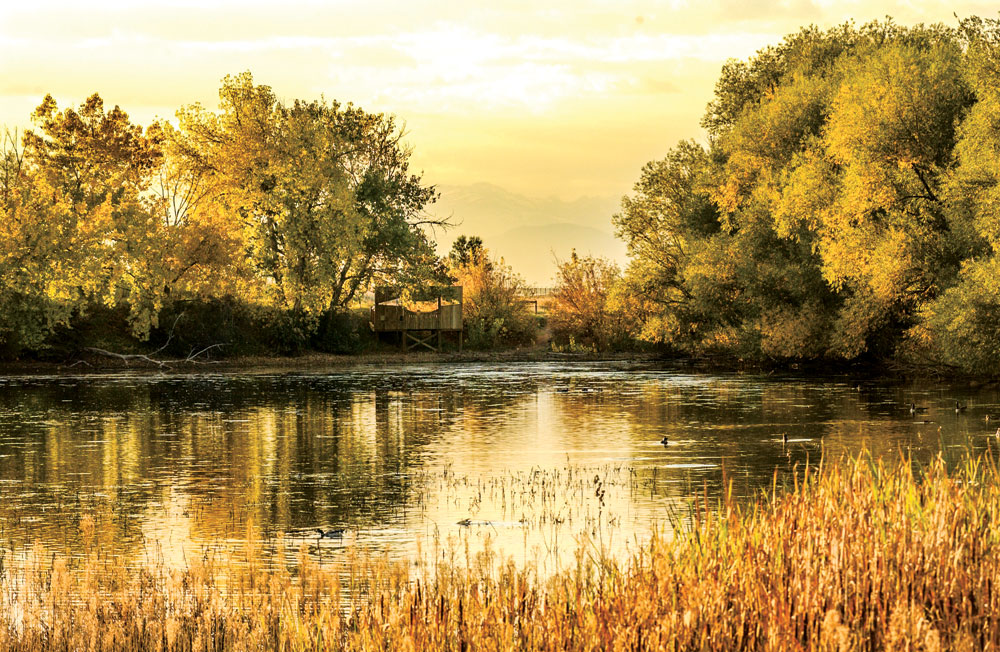
The 9-acre lake at the heart of Bluff Lake Nature Center is fed by storm water from the Stapleton neighborhood.
“Even if we don’t see something rare, it’s nice to just walk around enjoying nature with people who have a similar interest,” says Ho.
Located on the eastern edge of Stapleton, Bluff Lake is a living laboratory that has been welcoming bird watchers, school students, scientists, walkers and joggers to its 123-acre wildlife refuge for over two decades. Yet remarkably, most people don’t know much about its history or mission.
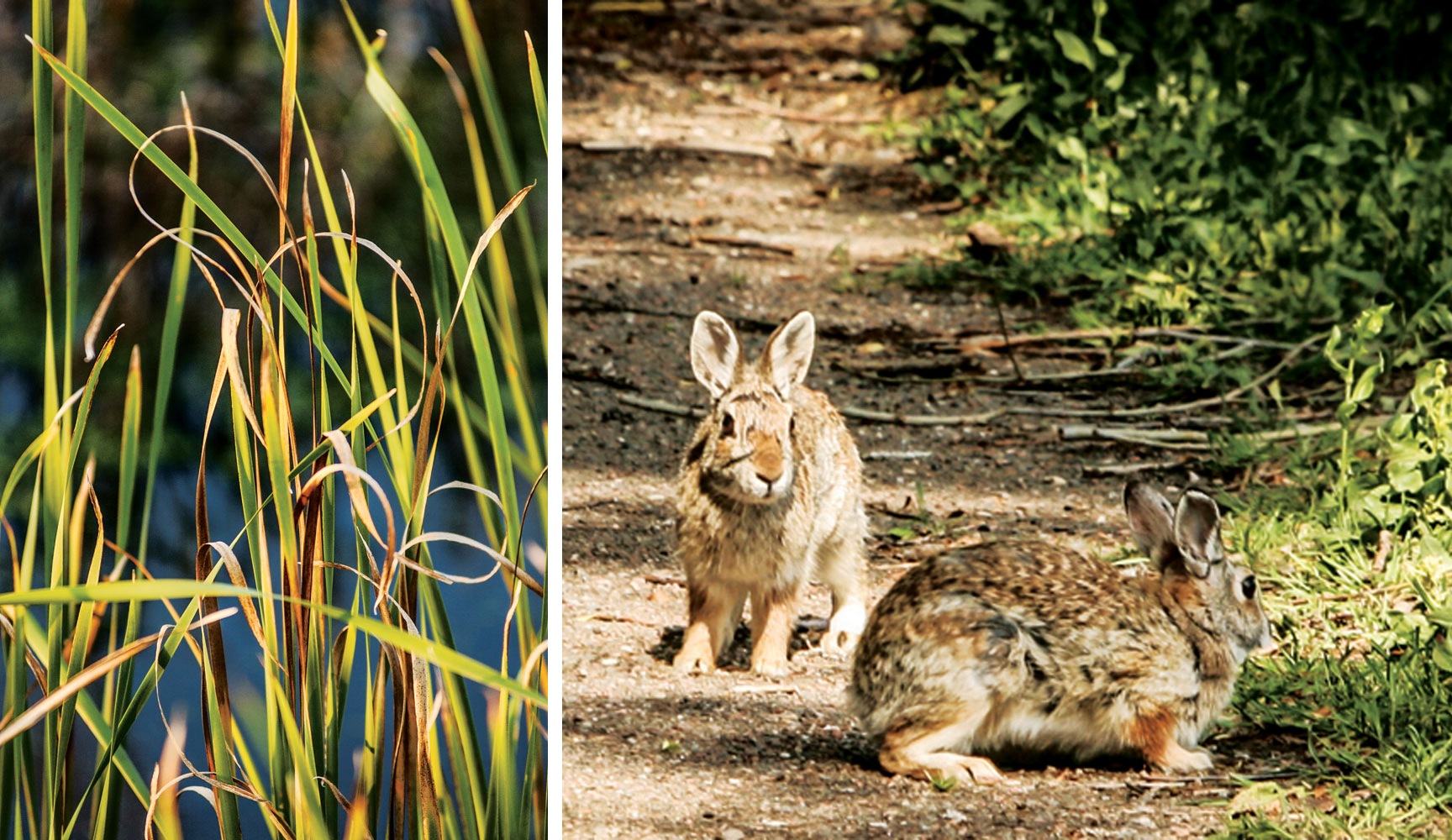
The riparian area hosts an abundance of plant and animal life including birds, rabbits, foxes, beavers, deer and a resident turkey.
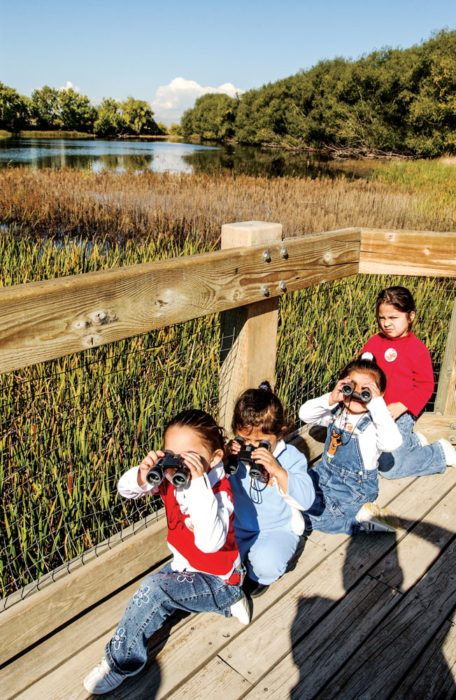
Since 1995, more than 100,000 school children have visited Bluff Lake Nature Center.
Bluff Lake’s Mission: Inspire People to Protect and Connect with Nature
Bluff Lake was created in the late 1800s as part of an irrigation system for nearby farms. In the 1940s, the property was acquired by the city of Denver to become part of the Stapleton Airport, to be used as a “crash zone.” When the airport closed in 1995, the Sierra Club sued Denver for inadequate environmental protections that allowed toxic chemicals to spill into nearby Sand Creek. As part of that settlement, the city invested over three million dollars to restore the land and enhance its wildlife habitat. A non-profit organization was formed to manage the property, and in 2008, the Bluff Lake Nature Center received full ownership. Its primary mission? To educate and inspire people to protect and connect with nature.
“Bluff Lake is a fantastic educational tool that allows us to teach people about the natural world, about conservation and the importance of preserving open space,” says Rachel Crouch, executive director of Bluff Lake Nature Center. Each year, more than 5,000 Denver Public School students visit Bluff Lake on fieldtrips.
Ninety-five percent of the schools that participate serve low-income students, who often don’t have the opportunities to connect with nature and wildlife. During the summer, an additional 300 kids participate in summer camps. “We have a very diverse community that comes here and it’s so gratifying when we see kids who have come here on field trips, then bring their parents back because they’re so excited to show them what they’ve learned.”
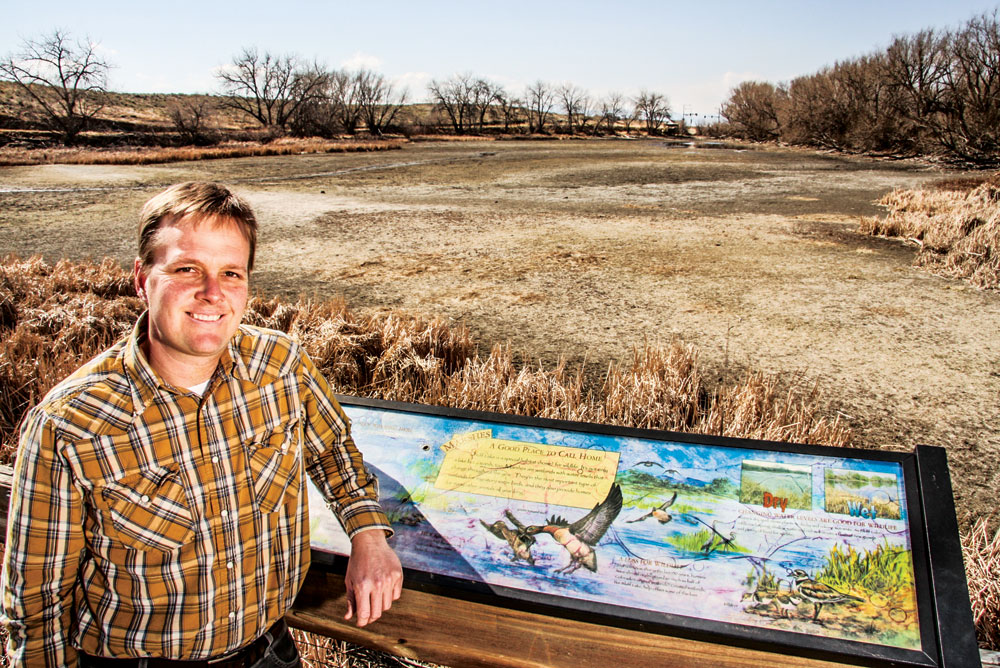
Former Bluff Lake Executive Director Glenn Fee stands at the observation deck. Before the dam was rebuilt, the lake was periodically dry. (2008 Front Porch photo)
Getting adults more involved at Bluff Lake is one of Crouch’s goals. She assumed the top job 18 months ago after serving as its education manager. She’s hoping to form an insect club, similar to the birding group, which would encourage insect lovers to explore and document insects found on the property.
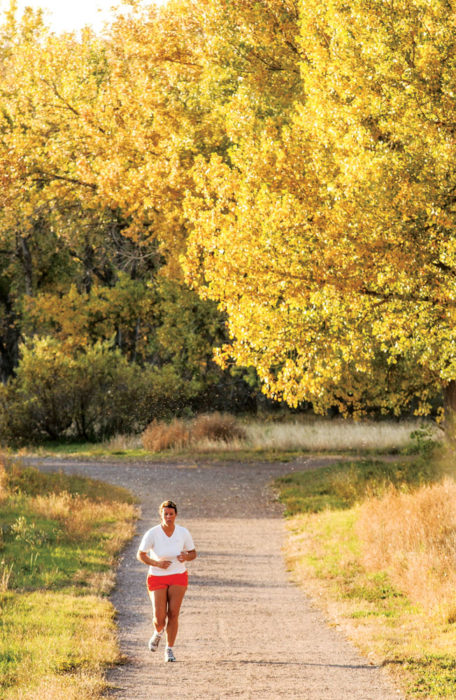
A jogger enjoys a scenic workout along the 1-mile trail around Bluff Lake.
So far, 98 species of spiders found at Bluff Lake
Professional scientists have been utilizing Bluff Lake as a giant outdoor laboratory for years. Paula Cushing is a biologist with the Denver Museum of Nature and Science who studies spiders. Since 1999, she has been leading citizen science workshops at Bluff Lake for a bio-diversity survey. After a short training session, the volunteers fan out across the area to collect and preserve spiders.
“Bluff Lake is an ideal open laboratory. It has diverse habitat, from the grassland at the top of the bluff down through the riparian area by the lake. It contains several different habitats where we can see all kinds of spiders,” says Cushing. “It’s been a win-win-win situation. It’s good for my project. It’s good for Bluff Lake, because we provide them with a list of species that live here. And it introduces local people to this very special place.”
So far, Cushing and her volunteers have discovered 98 different species of spiders at the lake. Cushing says studies are important because so very little is known about spiders.
“Mammals and birds have long been studied. There are about 10,000 species of birds and 5,400 species of mammals (as of Dec. 2023, this number has been updated to more than 6,495 species of mammals identified by scientists.) But there are over 48,000 species of spiders and that number is increasing all over the world as we discover new species,” says Cushing. “We need to get a baseline of information about spiders before we can even begin to understand how changes in habitat and climate are affecting them.”
Birth control for prairie dogs?
Dan Salkeld is a biologist at Colorado State University who is also using Bluff Lake as a laboratory. He is studying a problem vexing many front-range communities that are rapidly being developed: over-population of prairie dogs. As the Stapleton neighborhood was built, prairie dogs moved to Bluff Lake in droves.
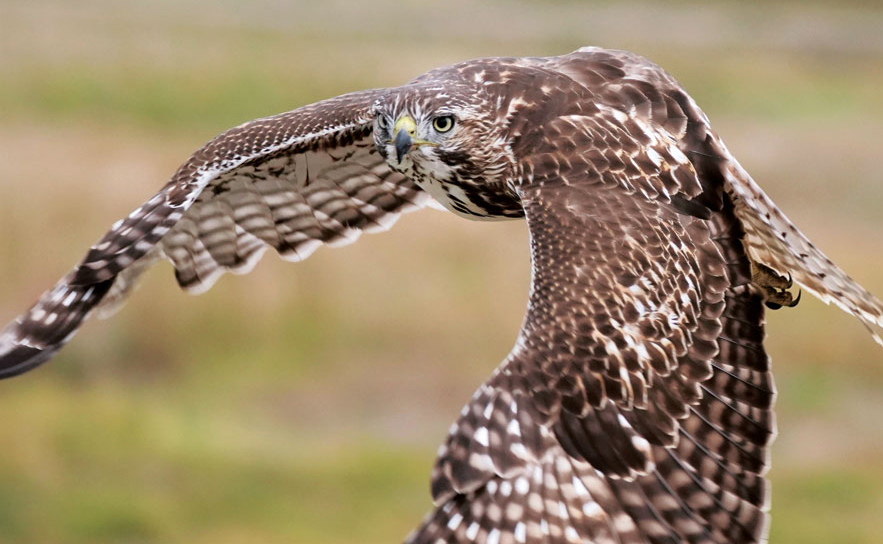
This red-tailed hawk at Bluff Lake was photographed by George Ho, who leads the Bluff Lake Birders group.
“Prairie dogs are considered a keystone species. The holes they dig become homes for other animals so they are good for the ecosystem,” says Salkeld. “The problem is when too many populate an area, they can cause erosion and destroy habitat.”
Salkeld is testing whether birth control will bring the population back into balance. A year ago, his team injected two dozen female prairie dogs at Bluff Lake with a contraceptive. He’s still analyzing the data but a follow-up visit to Bluff Lake this fall seemed to indicate that fewer babies had been born. He says his work at Bluff Lake will be very useful for other communities that want non-lethal options to manage prairie dogs.
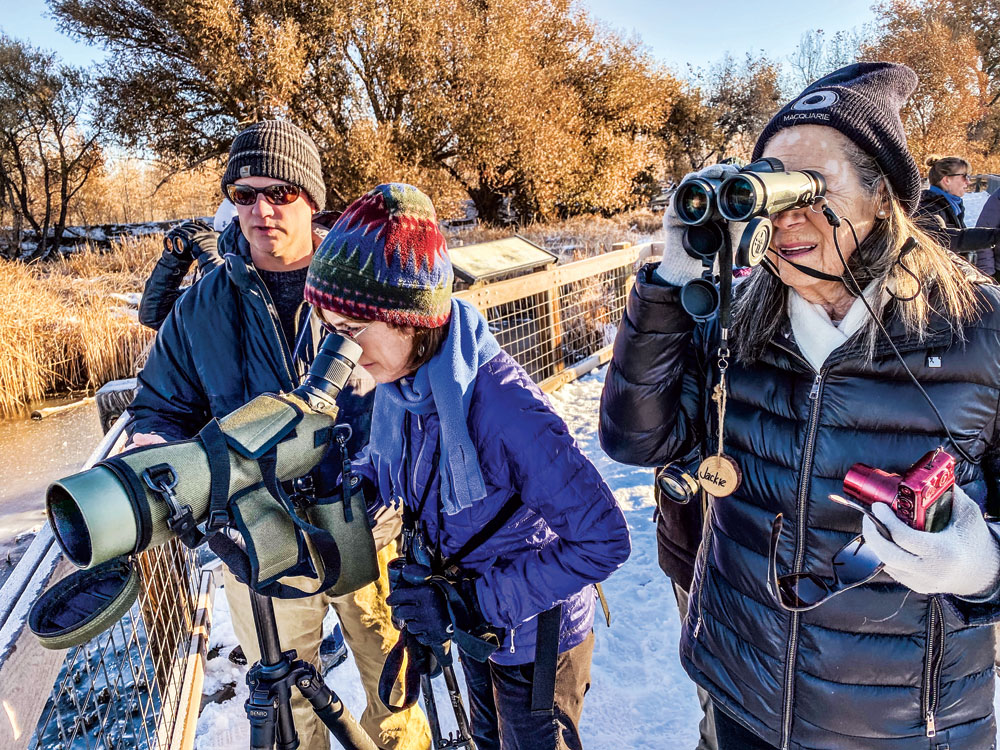
Bird watchers of all abilities are invited to join the monthly bird walk. This summer, following Hurricane Dorian, bird watchers from all over the state flocked to Bluff Lake to see a bird normally found in Central America, the Groove-billed ani.
Executive director Crouch says another reason scientists flock to Bluff Lake Nature Center is because as a private, non-profit organization, there are fewer regulatory hurdles to overcome than a government-managed property. She’s quick to add, however, that since Bluff Lake doesn’t receive government support, funding is always a challenge. Over the next three years, Crouch hopes to raise enough money to erect a building that would house an information center, a classroom and restrooms.
“During the past few years, we’ve spent our energies restoring the site and protecting it. Now we want to take the next step and make it even more accessible for people to visit,” says Crouch.
More wildlife photos by George Ho, from his visit to Bluff Lake on November 18, are posted below.

Gertrude, resident Wild Turkey Hen.

Mule deer.

Red-tailed Hawk.
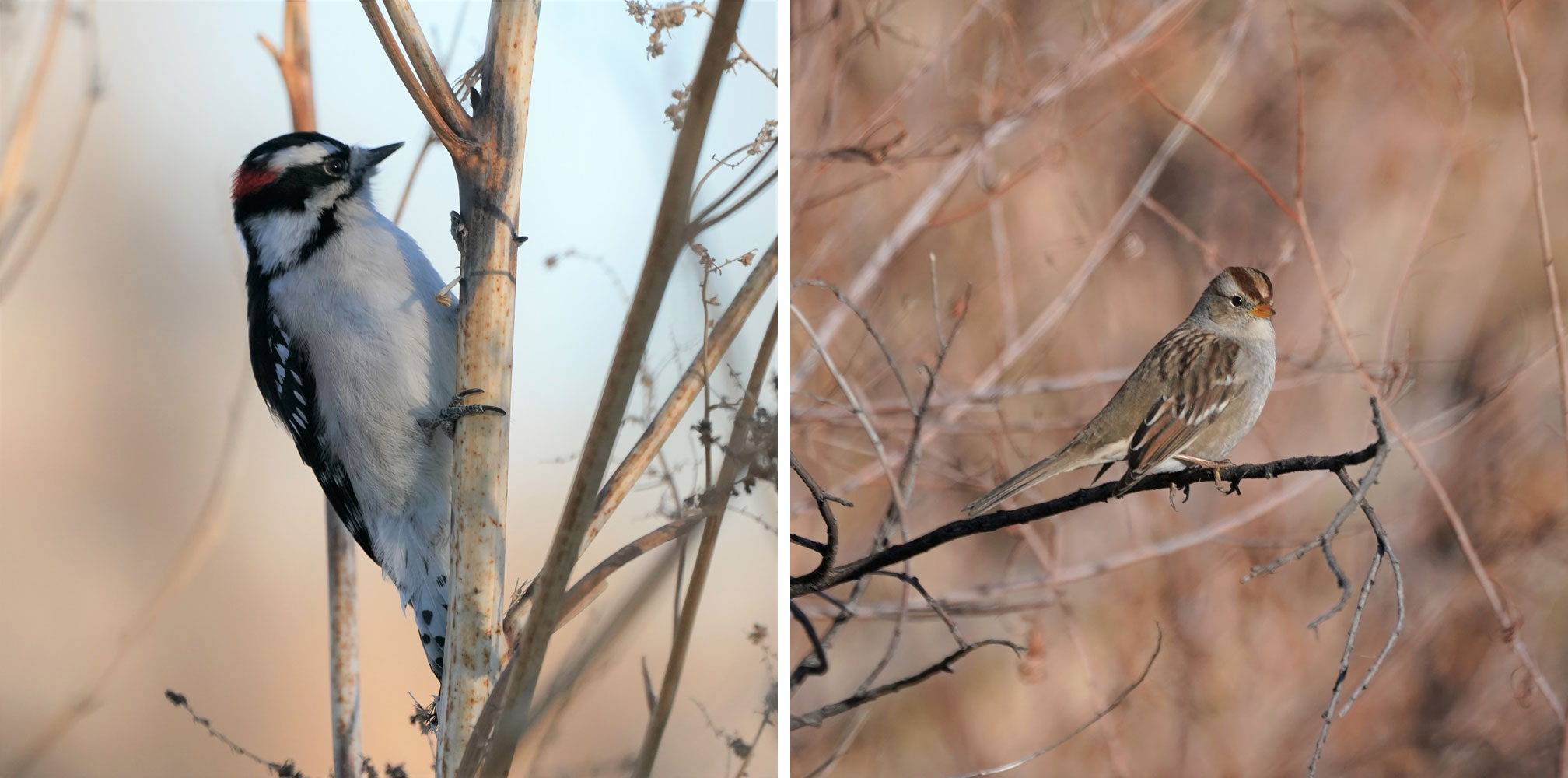
Downy Woodpecker and White-crowned Sparrow.




0 Comments